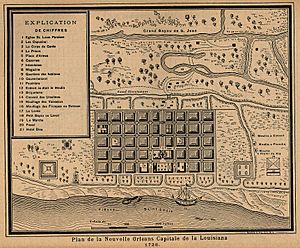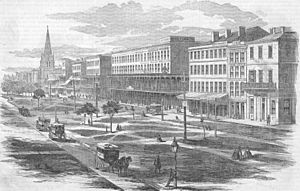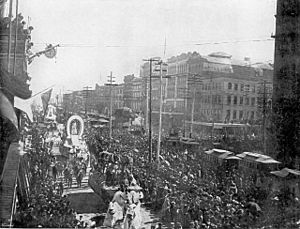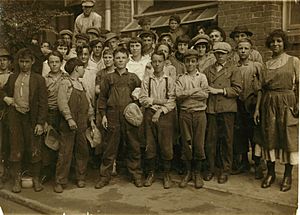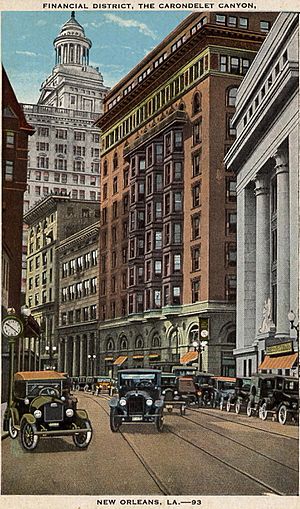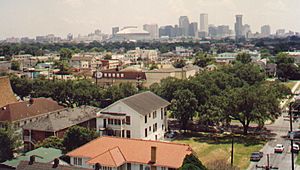History of New Orleans facts for kids
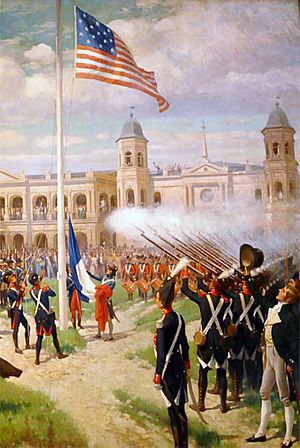
New Orleans, Louisiana, has a fascinating past! It was founded by the French in 1718. Later, it was controlled by the Spanish, then briefly by the French again. Finally, the United States bought it in the Louisiana Purchase in 1803. During the War of 1812, the famous Battle of New Orleans in 1815 was a big victory for the U.S.
In the 1800s, New Orleans became the largest port in the Southern United States. It shipped out most of the nation's cotton and other goods. When the American Civil War started in 1861, it was the biggest city in the South. Union forces quickly aimed to capture it. Today, New Orleans is famous for its unique culture, amazing music, and annual Mardi Gras celebrations. Even after the huge damage from Hurricane Katrina in 2005, the city has worked hard to rebuild and bounce back.
Contents
Colonial Era: French Beginnings

The land where New Orleans now stands was formed around 2200 BC. The Mississippi River deposited silt, creating the delta. Before Europeans arrived, Native American people lived here for about 1300 years. They built mounds and earthworks. Later, Native Americans created an important trade route between Bayou St. John and the Mississippi River. This area was settled as early as 400 A.D.
French explorers and traders came to the area in the 1690s. Some settled among Native American villages. By 1701, the French built a small fort called "St. Jean" near the bayou. These early settlements were within what is now New Orleans, even before the city was officially founded.
New Orleans was officially founded in 1718 by the French. It was named Nouvelle-Orléans (New Orleans) by Jean-Baptiste Le Moyne de Bienville. Bienville chose this spot for several reasons. It was high ground along a bend in the Mississippi River, which created a natural levee. It was also next to a trade route that connected the Mississippi to Lake Pontchartrain via Bayou St. John. This route offered access to the Gulf of Mexico. The city was named after Philip II, Duke of Orléans, who was the Regent of France at the time. In 1722, New Orleans became the capital of French Louisiana.
In September 1722, a hurricane hit the city, destroying most buildings. After this, city leaders made sure the city was rebuilt using a strict grid pattern. This grid plan can still be seen today in the streets of the French Quarter.

Two large lakes nearby, Lake Pontchartrain and Lake Maurepas, are named after French officials. Lake Pontchartrain is named after Louis Phelypeaux, Count Pontchartrain. Lake Maurepas is named after Jean Frederic Phelypeaux, Count Maurepas.
Spanish Rule and Rebuilding
In 1763, after the Seven Years' War, France secretly gave the Louisiana colony west of the Mississippi River, including New Orleans, to the Spanish Empire. This was to make up for Spain losing Spanish Florida to the British.
A Spanish governor arrived in 1766. However, French and German settlers wanted New Orleans to be French again. They forced the Spanish governor to leave in the Louisiana Rebellion of 1768. A year later, Spain took back control. They punished some of the rebellion leaders but forgave others who promised loyalty.
New Orleans faced two major fires in the late 1700s. The Great New Orleans Fire of 1788 destroyed 856 buildings. In 1794, another fire destroyed 212 buildings. After these fires, the city was rebuilt with bricks instead of wood. Many of the 18th-century buildings in the French Quarter today were built during this time. This includes St. Louis Cathedral, the Cabildo, and the Presbytere. These buildings show Spanish architectural styles, with inner courtyards and wrought-iron balconies.
In 1794, the Carondelet Canal opened. This canal connected the city to Lake Pontchartrain, boosting trade. In 1795, Spain allowed the United States to use New Orleans' port facilities. This was known as the "Right of Deposit."
Back to France, Then to the U.S.
In 1800, Spain secretly agreed to give Louisiana back to France. This was confirmed by other treaties in 1801 and 1802.
Then, in April 1803, Napoleon sold all of Louisiana (New France) to the U.S. in the Louisiana Purchase. A French official, Pierre Clément de Laussat, arrived in New Orleans in March 1803. He formally took control for France on November 30, only to hand it over to the U.S. on December 20, 1803. Before leaving, he created New Orleans' first city council.
19th Century: Growth and Change
By 1805, New Orleans had about 8,500 people. This included white residents, free black people, and enslaved individuals. The city was known for its mix of cultures and languages. It grew quickly as people from different backgrounds moved there. Many French-speaking people, including white and free people of color, came from Haiti after its revolution.
The Haitian Revolution (1791-1804) inspired enslaved people in New Orleans. In 1811, hundreds of enslaved men revolted in the 1811 German Coast uprising. This was the largest slave uprising in U.S. history. The rebels marched towards New Orleans, burning some plantation houses. White militias and the United States Army quickly stopped the uprising. Many rebels were killed or executed.
War of 1812 and the Battle of New Orleans
During the War of 1812, the British tried to capture New Orleans. But in early 1815, they were defeated by Andrew Jackson's forces at Chalmette, just downriver from the city. The American government knew the British were coming and prepared. General Andrew Jackson led a mix of regular soldiers, militia, and naval forces. Even privateers led by Jean Lafitte helped in the battle.
The British attacked on January 8, 1815. They faced strong American defenses and suffered huge losses. About 2,000 British troops were killed or wounded, including their commander. The British then gave up and left. General Jackson kept the city under martial law for several months to ensure safety.
New Orleans Before the Civil War

The city's population doubled in the 1830s. Many new settlers arrived, including German and Irish immigrants. By 1840, New Orleans had about 102,000 people. It was the third-largest city in the U.S. and the biggest in the South.
During this time, New Orleans saw many advancements. Natural gas was introduced around 1830. The Pontchartrain Railroad, one of the first in the U.S., opened in 1831. The first steam-powered cotton press started in 1832. A public school system began in 1840. Trade on the Mississippi River boomed, making the city a busy commercial hub.
In 1836, the city was divided into three parts, each with its own government. The first was the French Quarter, the second was Uptown, and the third was Downtown. They were almost like separate cities for two decades.
The United States Mint opened a branch in New Orleans in 1838. It produced both gold and silver coins. This showed how important New Orleans was as a financial center. The mint operated until 1861.
In 1849, a levee break upriver caused the worst flooding the city had ever seen. This flood, known as Sauvé's Crevasse, left 12,000 people without homes. New Orleans has not had flooding from the Mississippi River since then.
The Civil War and Union Capture
New Orleans was captured by the Union early in the American Civil War without a major battle in the city itself. This saved it from the destruction many other Southern cities faced. Because of this, New Orleans still has many 19th-century buildings.
The Union wanted to capture New Orleans because of its political and commercial importance. In January 1862, Captain David Farragut and his fleet sailed for New Orleans. The city was defended by two forts, Fort Jackson and Fort St. Philip. On April 16, the Union fleet attacked the forts. They bypassed them and anchored in front of New Orleans on April 25. The forts surrendered on April 28, and Union forces occupied the city.
General Benjamin Butler took command of New Orleans. He enforced strict rules but also made efforts to keep the city orderly and healthy. Later in the war, General Nathaniel P. Banks commanded the city.
Reconstruction and Later 1800s
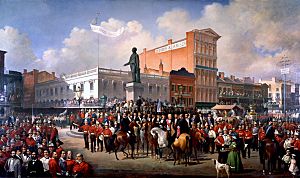
New Orleans was the capital of Louisiana again from 1865 to 1880. During the Reconstruction period after the Civil War, the city was a center of political change. Both black and white citizens were elected to government roles. The city even had a racially integrated public school system.
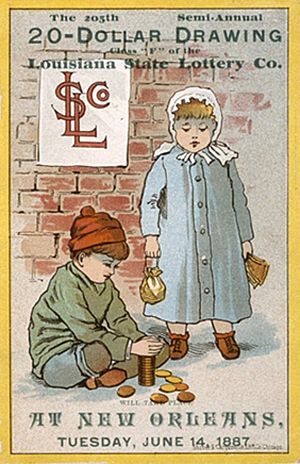
In 1870, New Orleans annexed the city of Algiers across the Mississippi River. It also expanded upriver, annexing Carrollton in 1874.
On September 14, 1874, a group called the White League fought against the Republican police in the French Quarter. The White League briefly took control of the government. However, United States troops quickly stepped in and restored the Republican government.
The New Orleans Mint reopened in 1879, mainly producing silver coins. The city also hosted the World Cotton Centennial in 1884, which helped start its tourist economy. In 1886, an electric lighting system was introduced. By the 1890s, most of the city's public transportation, like streetcars, became electric.
New Orleans had a large, educated black population. However, like other Southern cities, it faced Jim Crow laws that enforced strict racial segregation. These laws limited job opportunities and denied black children access to public high schools. In 1896, the famous Plessy v. Ferguson Supreme Court case, which started in New Orleans, upheld segregation. This meant segregation would be enforced even more strictly for many years.
In 1896, Mayor John Fitzpatrick helped create the city's first free public library, now known as the New Orleans Public Library.
Battling Epidemics and Modernizing the City
Throughout the 1800s, New Orleans often suffered from epidemics of diseases like yellow fever, malaria, and cholera. Doctors didn't understand how these diseases spread. Poor sanitation and a lack of public water systems made things worse. However, the city successfully stopped its last yellow fever outbreak in 1905.
Draining the City for Growth
Much of New Orleans is located below sea level, between the Mississippi River and Lake Pontchartrain. The city is protected by levees. For a long time, buildings were only built on slightly higher ground near the river. The areas between the river and Lake Pontchartrain were mostly wetlands, prone to flooding. This is why New Orleans got its nickname, The Crescent City.
In the early 1900s, engineer A. Baldwin Wood created a plan to drain the city. He designed large pumps that are still used today. Wood's drainage system allowed the city to expand greatly. However, it later became clear that much of the drained land would slowly sink, meaning many newer neighborhoods are now below sea level.
20th Century: New Challenges and Progress
In the early 1900s, many people in New Orleans still spoke French. However, French language use slowly declined over the century. In 1905, when yellow fever reappeared, the city quickly acted. They understood that mosquitoes spread the disease. So, they launched a huge campaign to drain standing water and educate the public. This effort stopped the disease from becoming a major epidemic.
In 1909, the New Orleans Mint stopped making coins. The city was also hit by major hurricanes in 1909 and 1915. In 1917, the famous Storyville District, known for its entertainment, was ordered closed by the Navy.
The Industrial Canal opened in 1923, creating a direct shipping route between Lake Pontchartrain and the Mississippi River. In the 1920s, old cast-iron balconies were removed from Canal Street to "modernize" it. Later, in the 1960s, the Canal Streetcar Line was replaced by buses. These changes were later seen as mistakes, and streetcars returned to Canal Street in the late 1990s.
The city's river levees almost overflowed during the Great Mississippi Flood of 1927. In 1927, a project began to fill in the shoreline of Lake Pontchartrain and build levees along the lake side of the city.
During World War II, New Orleans was important for building Higgins boats. These landing craft were crucial for the Allied victory in the war.
After World War II, New Orleans grew into a larger metropolitan area with many suburbs. The city's population grew for two decades after the war, as new neighborhoods were developed within the city limits.
Mayor DeLesseps "Chep" Morrison was elected in 1946. He served until 1961 and helped shape the city's growth after the war. In 1961, Victor H. Schiro became the city's first Italian-American mayor.
In 1965, the Mississippi River–Gulf Outlet Canal ("MR GO") was completed. It was meant to boost trade but also caused problems like saltwater intrusion and coastal erosion. In September 1965, Hurricane Betsy hit the city. A breach in the Industrial Canal caused severe flooding in the Lower 9th Ward. President Lyndon B. Johnson visited to promise federal aid.
In 1978, Ernest N. Morial became the first African-American mayor of New Orleans. Tourism greatly increased in the late 20th century, becoming a major part of the city's economy. New Orleans hosted another World's Fair in 1984, called the 1984 Louisiana World Exposition.
In 1995, the city experienced severe flooding from heavy rains. Water filled the streets faster than the pumps could remove it. On December 14, 1996, a large cargo ship, the M/V Bright Field, crashed into the Riverwalk mall. Luckily, no one died, but many were injured.
21st Century: Hurricane Katrina and Recovery
In May 2002, businessman Ray Nagin was elected mayor. He promised to fight corruption and run the city like a business.
Hurricane Katrina's Impact

On August 29, 2005, Hurricane Katrina made landfall near New Orleans. About 600,000 people evacuated before the storm. However, about 20% of New Orleans residents stayed, including those without cars or money to leave. Some took shelter in the Superdome.
The storm's eye missed the city, but strong winds caused damage and flooding. The situation became much worse when the levee and floodwall system protecting New Orleans failed. Levees on four of the city's canals were breached. This caused massive flooding in most of the city. As much as 80% of New Orleans was flooded, with water reaching depths of 25 feet in some areas. The damage from the storm was estimated to be billions of dollars. Hurricane Katrina became the costliest hurricane in U.S. history.
The storm caused 1,836 deaths, mostly in Louisiana. Half of those who died were senior citizens. On September 22, 2005, Hurricane Rita caused more flooding in New Orleans when recently repaired levees breached again.
Investigations after Katrina showed that the flooding was not just due to the storm's power. The United States Army Corps of Engineers had designed the levee system incorrectly. This was called "the costliest engineering mistake in American history."
Continuing Recovery
After Hurricane Katrina, many residents and businesses returned to rebuild the city. The storm had a huge, long-term impact on the city's economy and population. By 2008, the population had grown to over 330,000.
In 2010, Mitch Landrieu was elected mayor. He had widespread support across the city. In February 2017, a tornado hit New Orleans, causing power outages for about 10,000 homes. The governor declared a state of emergency.
Images for kids


